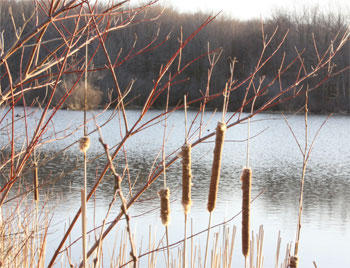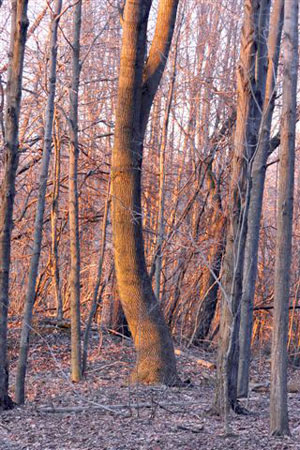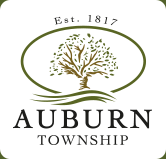 Township History
Township History
The first house in Auburn belonged to Bildad Bradley who came from Massachusetts to Newbury in the early 1800’s. He started to build a home there in 1814 and decided he had built it in the wrong place, so he just moved it to Auburn.
The first school in Auburn was taught by Mrs. Betsey (Orton) Wilcox in the summer of 1816. The first school house was built the following year.
The following stories are taken from a manuscript entitled “Stories of Auburn” by Jean Davis Fugman, Donald May and Raymond Andrews.
Mrs. Fugman, still an active Auburn resident, very kindly allowed the Board of Trustees to photocopy her manuscript. Mrs. Fugman, a local treasure, maintains her keen interest in Auburn and its history and is often present at meetings of the Board of Trustees quietly observing the proceedings.
We are pleased to share some of her stories with the citizens of Auburn Township.
Auburn History
 Dear reader, try to visualize in your mind’s eye the area you know now as nothing but unbroken forest for miles and miles. Trees reaching to the zenith and so thick the sun only knew a patch here and there. That is what the pioneers found here. Imagine the work to clear a patch of ground to “lay up a cabin” and after you move in, discover that a bear has moved in also! How about a few Indians? These Indians wanted food, whiskey, guns and the oldest boy and girl to drag over the hill and maybe never hear from again.
Dear reader, try to visualize in your mind’s eye the area you know now as nothing but unbroken forest for miles and miles. Trees reaching to the zenith and so thick the sun only knew a patch here and there. That is what the pioneers found here. Imagine the work to clear a patch of ground to “lay up a cabin” and after you move in, discover that a bear has moved in also! How about a few Indians? These Indians wanted food, whiskey, guns and the oldest boy and girl to drag over the hill and maybe never hear from again.
Auburn was not settled until 1815. There were no roads or bridges and then there were the Auburn woods, which were another problem for the pioneers. Travelers were terrified of the woods which harbored wolves, bears, snakes and goodness knows what else.
Bildad Bradley was born in Massachusetts in 1780 and came to Auburn from South Newbury in 1814, started a house on the north line of the township and later discovered he had the house on the wrong lot and in 1815, he took it down and moved it further west. This would be somewhere near the bend in Messenger Road. He married Emily Veasy and they had four children. Two died young, one being the first buried in the South Newbury Cemetery. Mr. Bradley helped lay out the State Road and carried the front end of the chain.
John Jackson came to Auburn in 1815 and built a house south of the present I.M. Cavanagh home. In 1816 he built the first frame barn in Auburn.
Zadock Reuwee married Lury Snow in 1814. Lury was a daughter of Oliver Snow, and they came to Auburn in 1815. At this time they had one child named Lorin. Mr. Reuwee built a log house east of the State Road and commended to clear up his farm. On the 16th of December, 1817, he left home on business, and in his absence, his wife went to the neighbors’ on an errand leaving the little one in the house asleep. She was gone but a short time, but upon returning discovered the house was on fire. She reached the house as quickly as possible and some neighbors also arrived but they were too late to rescue the child. The bones were gathered up and buried at the center of the township. Elder Seward of Aurora preached the sermon which was the first funeral in Auburn. Mr. Reuwee was also the first to file a suit from Auburn in the county court.
William Crafts walked to Auburn from Gorham, Ontario County, New York in 1815, bought the whole Ely tract of 1,176 acres then walked back to Gorham. He was married in January 1816 and they returned to Auburn in February 1816. Their son Jeremiah was the first child born in Auburn. Mr. Crafts later built the largest house in the township at that time. This is now the home of the Maxwell family south of Auburn Corners on Route 44.
David Smith Sr. came to Auburn in 1816. He was a soldier in the American Revolution and his was the fifth family in Auburn. He was appointed postmaster and served 15 years. He then resigned. The first little school was held in his house in the summer of 1817 and was taught by Mrs. Betsy Orton Wilcox.
Others coming to Auburn in 1816 were Morgan Orton, Austin Richards, Benjamin Woods and Pardon Wilbur. George Antisdale in 1818, Joseph Bartholomew and Elijah Canfield in 1819, Henry Canfield and J. Palmer Bartholomew in 1821, and Oliver Snow in 1822. Some stories of these early settlers are very interesting, a few of which follow.
Did You Know?
That vast network of paved roads that afford easy auto travel today in the United States was the dream of an Auburn man. Here is his history:
Martin Dodge, youngest son of Joseph and Hannah Dodge, was born May 27, 1851 at the corner of Bartholomew and Auburn Center Roads in Auburn.
During his boyhood on the family farm, he attended the district school and when he was 17, he began to teach in one of them. He taught during the winter for 8 years. During this time, he attended Hiram College for 4 years and also Buchtel College in Akron for a year.
When he was 25, he studied law in Cleveland and was admitted to the bar and was a prominent attorney in the area for several years.
In 1891, he was elected to the Ohio Legislature and served for 10 consecutive years.
He was one of the Republican leaders in the House and also served 4 years in the Senate.
In 1893, Governor William McKinley, named him President of the Ohio Road Commission.
When McKinley became president of the United States, he appointed Dodge to the office of Public Road Inquiry in Washington.
Dodge organized a “good roads train” and toured the nation going to every state. In each state, he supervised the building of a mile of “object lesson road”.
He was instrumental in obtaining Federal Aid and wrote the first bill introduced in Congress asking the federal government for support for the building of good roads through the United States. Certainly, Mr. Dodge was one of the Township’s noteworthy citizens. One wonders what he would say after traveling over Munn, Bainbridge, Messenger Roads and Route 422 today in the township where he was born. This is 1986!! We cannot even Dodge the holes!
Editor’s Note: Yes. In 1986, 95% of the roads in Auburn were gravel. We’ve come a long way in the last few years since an aggressive road plan was instituted in 1992.
Mr. and Mrs. Ralph Shaw lived on the Auburn-Troy town line road that is named for his family. Mrs. Shaw was Dorothy Herrington, daughter of Harry Harrington of Mantua.
Ralph can trace his genealogy back to Moses Cleaveland and the beginnings of the Connecticut Western Reserve. He has many interesting stores to tell and one of these is of the big snowstorm November 8, 1913.
Ralph and his father, Harry Shaw had gone down to Mantua Grain and Supply with the team for a load of coal. They returned home with the coal and later during the night it began to snow. By morning it was impossible to use the horses, the snow was so deep. Ralph declares he never saw so much snow come down so fast. One man in Burton had to tunnel his way to the barn.
Colonial History
Written November, 1985
History by Jean Fugman
The Northwest Territory was claimed by many colonies during the 1700’s. As early as 1714, Governor Spottswood of Virginia led an expedition over the Alleghenies to the Ohio and claimed these lands for England and Virginia.
In 1748, Thomas Lee, builder of Stratford Hall, home of the Lee’s in Virginia, along with Lawrence and Augustine Washington, organized the “Ohio Company” and received a grant of one-half million acres in the Valley of the Ohio.
In 1753, the Ohio Company, under the protection of Virginia, made plans to locate their colony in the Ohio Valley. During this time, the French were also trying to occupy and hold the line of the Ohio. For this reason, the Governor of Virginia chose George Washington to take a message to the commander of the French forces to demand a reason for their intrusion in British dominions. Washington arrived at the junction of three rivers where Fort Pitt was built and still later, the city of Pittsburgh. From there he went to the French posts at Venango and Le Boeuf and warned the commander that the rights of Virginia would not be violated. The French told him they would “seize every Englishman in the Ohio Valley”. Thus began the “Seven Years War” or “French and Indian War”.
During the 1760’s, the pioneers, traders, and settlers were pushing down the Ohio River from Fort Pitt. In 1769, a stalwart, broad shouldered man, stood on a wild promontory high above the Ohio River near Wheeling Creek. He was alone except for his dog and his long rifle. Before him lay an island round and green like a lily floating on the water. This man and his family were some of the very first in the Ohio Territory. He was Col. Ebenezer Zane. He returned to Berkeley County, Virginia to tell his people about the Ohio country and persuaded them to return here with him. On the return trip to Ohio, Col. Zane brought along his brothers: Silas, Andrew, Jonathan and Isaac. Others who came were Mrs. Zane’s brother, the McCollocks, Wetzels, Bennets and Metzars. They commenced to build a Fort to be known later as Fort Henry, named for Patrick Henry. Col. Zane then built a house a few hundred yards from the Fort. Many early pioneers sat at Col. Zane’s fireside — Gen. George Rogers Clark, Simon Kenton, Daniel Boone and Lord Dunmore, Governor of Virginia. There also, Cornstalk, Chief of the Shawnees, had made a deal with Col. Zane, trading the island in the river opposite the settlement for a barrel of whiskey. This is Wheeling Island.
Descendants of the Lewis and Wetzel families may be found in the area.
In 1786, Connecticut ceded her claims to the Northwest Territory to the United States. In 1795, Connecticut executed a deed to John Caldwell, Jonathan Brace and John Morgan, trustees for the Connecticut Land Co. for 3 million acres of the Reserve, lying west of Pennsylvania for $1,200,000. or $0.40 cents an acre.
The management of affairs of the Connecticut Land Co. was given to seven directors. Moses Cleaveland was one of the directors and was made general agent. Moses Cleaveland, Superintendent; Augustus Porter, Deputy Superintendent and Principal Surveyor; Amzi Atwater, Surveyor; and Seth Pease, Mathematician and Surveyor; and others, began their journey to “New Connecticut” in the Spring of 1796. They ascended the Mohawk River through locks at Little Falls, and from what is Rome, NY today, they crossed into Wood Creek. From there they crossed Oneida Lake, down the Oswego to Lake Ontario and from there coasted along the lake to Niagara. There they met “Red Jacket” and the chiefs of the six nations and from those Indians, they purchased the rights to the lands on the Reserve for 5000 pounds New York currency – to be paid in goods to the Western Indians and two beef cattle and 100 gallons of whisky to the Eastern Indians.
June 27, 1796, they set out from Buffalo, some in boats and some walking on the banks. They arrived at Conneaut, one party going down the Pennsylvania line to survey and the other, under General Cleaveland, coasted along the lake to the Cuyahoga which they reached on July 22 and there began the survey of the city of Cleveland, Ohio.
In 1798, Territorial Governor, Arthur St. Clair, by proclamation organized this area and gave the name Washington County to the entire Western Reserve. This was later changed to Jefferson County.
In 1800, Trumbull County was created by proclamation.
In 1805, Geauga was the second county named on the Reserve.
Amzi Atwater was one of the last in this survey party to return home. He ran the final survey on the east line of Portage and Geauga County to Lake Erie. The southern tract in Auburn Township is named for the Atwater family.
The first survey party into the Reserve had their share of hardships and Amzi Atwater, a member of this group, was no exception. One of the men in Atwater’s group became ill and Amzi did all he could to keep the man comfortable and tried to get back to the settlement at Cleveland where better care would be possible but the man died before they could reach Cleveland.
Another story about Amzi follows: He left Painesville in December of 1801 or 02 and walked all day, the trail being filled with heavy snow. That night he was near Butternut Creek. Tired and nearly frozen, he walked on until he was near Judge Stone’s in Burton Township. At ten o’clock, he was so chilled and sleepy he decided to “lay down and die”. The snow was packed away from the tree and he lay down between two roots and pulled his coat and knapsack over him, never expecting to wake again. The snow covering took away the chill, and after a sleep, he awoke, his first thought being, “Am I on earth or not”. He was answered by a screech but upon listening to the sound he discovered the sound was regular. He thought he must be near Col. Jedediah Beards’ sawmill. Rubbing his limbs to life, he got up and started forward. Guided by the sound of the mill he walked on and came to a log crossing the stream at the mill. He could not walk it! When the mill stopped he called and Silas Burke, the sawyer, came to him and put him astride the log. He was so cold and numb he could not stand. Burke, working carefully, step by step, drew him backwards on the log, across the stream and up the hill to the house. Col. and Mrs. Beard cared for him until he was able to continue his journey. Some 40 years later, he told the story to Alfred Beard, a son of Col. and Mrs. Jedediah Beard of his parents’ kindness to him.
In 1804 he returned to Hamden, Connecticut for his mother, Lois Alling Atwater and three sisters. A brother, Jotham Atwater built the “Brick Tavern” on the southeast corner of Pioneer Trail and Route 44 in Mantua.
On the northeast corner of what is Auburn and Mantua Center Road and Pioneer Trail, is a cemetery which is located on the old Oliver Snow farm. Mr. Snow gave the land for the cemetery to Mantua Township. There one will find the Atwater plot, one the oldest names on the Western Reserve.









